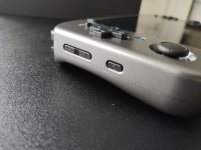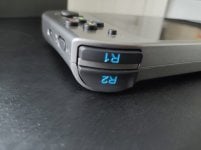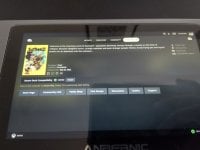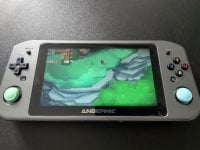Anbernic Win600 Impressions
Available for purchase today, and shipping this week, is Anbernic’s first handheld gaming PC, the Win600. I’ve had the chance to test the device, less than a week ago and will share my impressions of it here. I also plan to either do a full review after having spent more time with the device or update this post with specific games/tests requested (and/or videos). This article shares the out-of-the-box experience (save for the dual OS boot feature), so keep that in mind before diving in as the performance can vary based on tweaks. Now, without further ado, let’s take a closer look at Anbernic’s most powerful device to date!
There are two colour variants of the win600: black and white. They come with an AMD Athlon Silver 3050e Dali APU, 256GB of replaceable SATA storage and retail for $375 at launch. For the black variant, there is a lower-specced model that comes with the AMD Athlon Silver 3020e Dali APU and 128GB storage (still replaceable). This 3020e version is the cheapest model, retailing at an early sale price of $300 (goes for $335 later). Whichever model you buy, they will all come with the following items:
- Anbernic Win600 handheld
- 45W fast charging adapter
- USB-C charging cable
- Screen protector
More specs details can be found below:
Specs image courtesy of Anbernic
With these internals, the Win600 isn’t going to compete with beefier systems like the Steam Deck or AYANEO NEXT, but rather, it is marketed primarily towards 2D indie titles and Anbernic even says that it designed the device around this focus. The most telling aspect of this commitment is the symmetrical buttons layout with a focus on the D-pad. If you’ve been looking for a device to play such titles, you’re in for a treat as Anbernic has a more than decent track record of delivering membrane-cushioned D-pads and face buttons that hit the right spot on its retro handhelds like the RG350M and that hardware experience is on display on the Win600.
The feel is not as premium as the pricier AYANEO NEXT but as the company’s first Windows handheld, the Win600’s build is more than decent (slightly better overall quality than the first AYANEO device even). The weight is well distributed, making the device feel nice in the hands and weighing around 490g, it is the lightest newly-released Windows handheld out there. I simply love the comfort and portability it offers over its chunkier (and yes, better performing) contemporaries.
As with Anbernic’s other devices, button presses are very satisfactory, thanks to the membrane underneath. The joysticks are the same as the Switch ones, so you’ll know what to expect if you've used a Switch before. The location of the joysticks don’t really offer an ergonomic feel for twin-stick games and I could feel my thumbs getting cramped after 30 mins or less when playing Bioshock Remastered, especially if you wish to use the joysticks while still being able to reach the shoulder/trigger buttons. The latter are digital but also deliver decent feedback and are stacked, which is much more welcome than having them adjacent like Anbernic’s other consoles. The rear, lateral sides of the device also integrate bumps for better grip and they do help, although I wish they featured a textured finish to make them less slippery.
At the top of the device, you’ll see a recessed Reset button and a full USB-A and USB-C (with display port support) port. The latter are great inclusions, rather than just having USB-C ports, but I wish there were additional ports (as these are the only ones) to support accessories but in most cases these two should suffice. Next to the left shoulder keys is a ventilation outlet, and coupled with the cooling system, it does a pretty good job at keeping the device from heating up and I haven’t encountered uncomfortable heat dissipating from the device during my gaming sessions.
On the underneath of the device, you’ll see a 3.5mm headphone jack, a microphone and outlets for its two downward-facing speakers. These deliver decent audio output, akin to other Anbernic devices.
You might have expected to see a microSD card slot on the underside of the Win600 as I was myself, but Anbernic apparently decided against it. Even if the SATA storage can be upgraded, you’ll need to disassemble the casing and your storage options would be pricier compared to microSD. In addition to expanding the storage for games, having a microSD would enable the use of software like Batocera, without needing to use a USB that sticks out of the device.
In fact, one of the selling points of the Anbernic Win600 is that it is a multi-system device. The official website offers guidelines to install Windows 10, SteamOS or both on the handheld. I’ve opted to have a dual boot system with Windows 10 (upgradeable to Windows 11) and SteamOS. It’s a bit finicky to switch between systems as well as to install (tip: using a USB stick with more than 32GB for SteamOS installation solved my installation issues) but once done, I found it to be great to have the best of both worlds on a single device.
SteamOS works great on the Win600, and delivers the same UI that you get on the Steam Deck. This means a nice, console-like experience that natively supports navigation with the physical keys with easily accessible features like performance monitoring and adjusting the behaviour of the D-pad to work as a joystick for games like Eastward. Having a separate partition running Windows is great as it lets you play games from launchers or emulators that don’t fare that well on the Linux-based SteamOS. While controlling Windows is fine with the touchscreen, the Win600 features a handy toggle on the right flank to switch between mouse and controller modes. With mouse mode, you can use the joystick and physical keys to navigate on the device running Windows.
Now, when it comes to actually playing games on the Win600, you have to adjust your expectations accordingly and Anbernic already does highlight the focus on 2D indie titles. So think Jotun Valhalla Edition and Hyper Light Drifter; and these all play at a smooth 60fps and are indeed a blast to play on the device. And, depending on the games running on the Win600, I would get on average 2 hours of play time.
I also thought of the device as an adequate way to play through my backlog of older games and I was surprised by how well it handled 3D games as well. I played Yakuza Kiwami at 30-45 fps and Bioshock Remastered would deliver performance at 60+fps. However, twin stick games like the latter can be a pain to play over extended periods, while single-stick games like Eastward fare better. For other titles like Yakuza Kiwami that let you remap the controls, you can have a D-pad dominated setup and have a better experience. Nevertheless, I still wish that the sticks were better positioned, an approach akin to the Steam Deck layout might work, or just moving all the joysticks higher up or more towards the screen would have helped heaps to make the Win600 more versatile.
About versatility, I initially considered the Win600 to be a souped up retro handheld given Anbernic’s history of releasing retro emulation hardware. Older systems do work well on the device as it does on dedicated emulation systems, so I went for more demanding consoles like PS2 and Gamecube that Anbernic’s other devices don’t emulate so well. However, I was rather disappointed with the Win600 emulation performance on Windows out of the box. For PS2 emulation via PCSX2 (v1.7), Shadow of the Colossus would play at 18fps and crackling audio, while Zone of the Enders showcased better performance at 20-40fps but also had audio issues. You could try fiddling with the settings and performance might be title-dependent, but the out-of-the-box PS2 emulation experience isn’t that great with the AMD 3050e with Windows. Next, I tried Gamecube emulation via Dolphin and performance seemed better, with Metal Gear Solid The Twin Snakes and The Legend of Zelda Twilight Princess running at 30fps with some occasional audio issues. They were more playable than the PS2 games I tried but even smartphones like the Black Shark 4 Pro have better PS2 and Gamecube emulation than the Win600.
That said, emulation on the Win600 is apparently much better via Batocera, as Retro Game Corps indicated, but not so much for PS2 emulation. I haven’t tested Batocera myself as I’ve only had the device for less than a week and also because I’m not a fan of having to use a USB storage that sticks out of the device to access emulators.
All of this reverts back to how the Win600 is marketed: a device to play 2D PC games. At that, the device excels. Images are crisp on the 5.94” laminated display, the face buttons are smooth and deliver a tactile feedback that’s on point, and being smaller and lighter than its counterparts makes the handheld more portable. I also love the ability to switch between OSes on a single device based on my gaming needs. I will use it almost exclusively to play 2D indie titles or single-stick games myself, and if you’re looking for a system for such gaming needs, the Win600 will deliver.
However, this is a rather small niche that Anbernic is targeting and the device might have fared better if it targeted a larger audience. The Win600 feels like an early-adopter device and it’s not a bad one at that, especially considering that this is Anbernic’s first Windows-based device, but there is still room for improvements and I have a hunch that this might not be the last one from the company. And features that I’d like to see in future iterations are better positioned joysticks (yes, even if it is D-pad focused), a microSD slot, more USB ports and a textured grip.
The pricing of the handheld might also be an issue for many and whether it is worth all depends on your needs. The Anbernic WIn600 isn’t competing against its better performing counterparts and while there are other competitors like AYANEO and AYN with plans to launch more budget handheld gaming PCs, the Win600 is already available to purchase and ship (no crowdfunding and waiting times or restrictions based on location like the Steam Deck). So deciding whether this device is worth it is subjective and I can see some people who will want one while others who won’t even consider it.
As Anbernic’s first outing in the handheld gaming PC market, the Win600 isn’t too bad. It’s aware of its performance prowess (or lack thereof) and targets a niche need with this in mind. It feels more like an early adopter’s device to tinker around and Anbernic has a history of having its community flesh out the potentials of the device. So you might keep an eye out for more community support in the coming weeks.




























